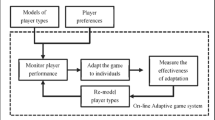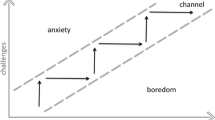Abstract
Learning practical abilities through exercises is a key aspect of any educational environment. To optimize learning, exercise difficulty should match abilities of the learner so that the exercises are neither so easy to bore learners nor so difficult to discourage them. The process of assigning a level of difficulty to an exercise is traditionally manual, so it is subject to teachers’ bias. Our hypothesis is about the possibility of establishing a relation between human and machine learning. In other words, we wonder if exercises that are difficult to be solved by a person are also difficult to be solved by the computer, and vice versa.
To try to bring some light to this problem we have used a game for learning Computational Logic, to build neuroevolutionary algorithms to estimate exercise difficulty at the moment of exercise creation, without previous user data. The method is based on measuring the computational cost that neuroevolutionary algorithms take to find a solution and establishing similarities with previously gathered information from learners.
Results show that there is a high degree of similarity between learner difficulty to solve different exercises and neuroevolutionary algorithms performance, suggesting that the approach is valid.
Access this chapter
Tax calculation will be finalised at checkout
Purchases are for personal use only
Similar content being viewed by others
Notes
- 1.
in Prolog: rule :- see(normal, left, ‘E’), doAction(move(right)).
References
Cheng, I., Shen, R., Basu, A.: An algorithm for automatic difficulty level estimation of multimedia mathematical test items. In: Eighth IEEE International Conference on Advanced Learning Technologies, 2008, ICALT 2008 (2008)
Clune, J., Beckmann, B.E., Pennock, R.T., Ofria, C.: HybrID: a hybridization of indirect and direct encodings for evolutionary computation. In: Kampis, G., Karsai, I., Szathmáry, E. (eds.) ECAL 2009, Part II. LNCS, vol. 5778, pp. 134–141. Springer, Heidelberg (2011)
Gauci, J., Stanley, K.: Generating large-scale neural networks through discovering geometric regularities. In: Proceedings of the 9th Annual Conference on Genetic and Evolutionary Computation. ACM (2007)
Gauci, J., Stanley, K.O.: Autonomous evolution of topographic regularities in artificial neural networks. Neural Comput. 22(7), 1860–1898 (2010)
Griffiths, T.L.: Connecting human and machine learning via probabilistic models of cognition. In: Technical Program, 10th Annual Conference of the International Speech Communication Association (2009)
Hausknecht, M., Khandelwal, P., Miikkulainen, R., Stone, P.: Hyperneat-ggp: a hyperneat-based atari general game player. In: Proceedings of the 14th Annual Conference on Genetic and Evolutionary Computation. ACM, New York (2012)
Olshausen, B.A.: Principles of image representation in visual cortex. In: Chalupa, L.M., Werner, J.S. (eds.) The Visual Neurosciences, pp. 1603–1615. MIT Press, Cambridge (2003)
Opitz, D.W., Shavlik, J.W.: Connectionist theory refinement: genetically searching the space of network topologies. J. Artif. Intell. Res. 6, 177–209 (1997)
Radcliffe, N.J.: Genetic set recombination and its application to neural network topology optimisation. Neural Comput. Appl. 1, 67–90 (1993)
Ravi, G., Sosnovsky, S.: Exercise difficulty calibration based on student log mining. In: Mdritscher, F., Luengo, V., Lai-Chong Law, E., Hoppe, U. (eds.) Proceedings DAILE 2013: Workshop on Data Analysis and Interpretation for Learning Environments (2013)
Risi, S., Lehman, J., Stanley, K.O.: Evolving the placement and density of neurons in the hyperneat substrate. In: Proceedings of the 12th Annual Conference on Genetic and Evolutionary Computation. ACM (2010)
Sadigh, D., Seshia, S.A., Gupta, M.: Automating exercise generation: a step towards meeting the MOOC challenge for embedded systems. In: Proceedings Workshop on Embedded Systems Education (WESE) (2012)
Stanley, K.O.: Compositional pattern producing networks: a novel abstraction of development. Genet. Program. Evolvable Mach. 8(2), 131–162 (2007)
Stanley, K.O., Miikkulainen, R.: Evolving neural networks through augmenting topologies. Evol. Comput. 10(2), 99–127 (2002)
Villagrá-Arnedo, C., Castel De Haro, M., Gallego-Durán, F.J., Pomares Puig, C., Suau Pérez, P., Cortés Vaíllo, S.: Real-time evaluation. In: EDULEARN09 Proceedings. IATED, Barcelona (2009)
Whitley, D., Starkweather, T., Bogart, C.: Genetic algorithms and neural networks: optimizing connections and connectivity. Parallel Comput. 14(3), 347–361 (1990)
Author information
Authors and Affiliations
Corresponding author
Editor information
Editors and Affiliations
Rights and permissions
Copyright information
© 2015 Springer International Publishing Switzerland
About this paper
Cite this paper
Gallego-Durán, F.J., Villagrá-Arnedo, C.J., Molina-Carmona, R., Llorens-Largo, F. (2015). Applying Neuroevolution to Estimate the Difficulty of Learning Activities. In: Puerta, J., et al. Advances in Artificial Intelligence. CAEPIA 2015. Lecture Notes in Computer Science(), vol 9422. Springer, Cham. https://doi.org/10.1007/978-3-319-24598-0_8
Download citation
DOI: https://doi.org/10.1007/978-3-319-24598-0_8
Published:
Publisher Name: Springer, Cham
Print ISBN: 978-3-319-24597-3
Online ISBN: 978-3-319-24598-0
eBook Packages: Computer ScienceComputer Science (R0)




